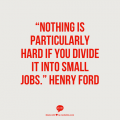Week Four of the Eight Week Plan. Watch the Waste
Written by Julia Bickerstaff // November 21, 2012 // Daily Juice // No comments
Remember in Week 2 we found “The Gap” – the difference between what we’d like our business to earn next year and what we, um, actually earned this year.

Now we’re now on a mission to close that gap. Last week we started by looking at pricing and today we’re going to look at waste.
Yes, odd as it sounds, waste.
But before we get bogged down in waste, let me explain for a moment why we are starting with tough and unglamorous stuff like pricing and waste rather than just getting stuck into some good ol’ sales and marketing.
Let’s say your business sells dolls for $40 each and the total cost of each doll works out as $25. Your profit on each one is $15.
You want to earn $15,000 so you work out you need to sell 1000 dolls. Quite a tall order.
As it happens, your fairy godmother stops by and shows you that you could increase your price by $7.50 and decrease your costs by $2.50. Wow, now you’re making a profit of $25 on each doll.
Not being greedy, you’re still happy to make a profit of $15,000 from the sale of the dolls. So now you need to sell 600 instead of 1000. Now that sounds rather more doable, doesn’t it!
So my point is – and extra emphasis because it’s *so very important* – that it’s mightily more efficient to fix the business than it is to just keep trying to sell more.
And that’s what we’re doing when we look at pricing and waste, we’re having a go at fixing the business.
And so, to waste….
What’s waste?

Waste is the hidden cost of the work we do. Best explained by examples methinks.
Retailers
If you’re not a Retailer you may look at those who are and wistfully eye up those “100% mark ups”. But don’t bother – Retailers never get to keep half the selling price of every product sold!
Never mind for the moment that the Retailer has overheads (big ones for physical stores), did you know that the average retailer sells less than half her stock at full price? Yup!
So while a Retailer may plan to sell, say, 1000 items for $40 each at a cost of $20,000 total, she’ll probably end up selling the lot for, say $28,000.
That makes the mark up on the product 40% rather than 100%. Same number sold but a lot less profit. Don’t fret about the maths, but the cost per sales dollar works out at 71 cents rather than 50 cents, and that difference ‘21 cents’ is the waste.
Now it’s not possible to totally eliminate this waste – but it is possible to decrease it. And what a difference that makes. Tips for doing so are a few para’s down, but just to whet your appetite Zara’s super success is due to them having all but eliminated waste because they sell more than 90% of their clothes at full price!
Makers
Whether you actually make your stuff yourself, or outsource it to someone else, if you’re in control of the design and the process then you’re a Maker.
Makers have some of the same waste issues as retailers – in that you may be producing stuff that doesn’t sell well – plus they have their own.
In the land of the Maker waste includes the very visible ‘material’ that gets discarded (the last little bit of a ball of wool), the stuff that goes off (the unsold cake at the end of the day) inefficiency in the process (think the cake batter left in the mixing bowl) and stuff that goes wrong (the burnt cakes!)
Makers who live by the maxim ‘look after the pennies and the pounds look after themselves” tend to be pretty good at managing waste but often when we put our minds to it, there are still savings to be made! Tips for doing so are below….
Doers
You’re a Doer if people buy your time rather than your product, and Oh there’s a lot of opportunity for waste when you’re a doer!
Before Doers embark start a business they do a little maths which goes something like this.
“I’m going to work 30 hours a week and get $100 an hour so even after allowing for holidays that’s a cool $144,000.”
Of course much of a Doer’s time is taken up with admin and marketing but there’s also a whole bunch of time that you could politely call “overservicing”.
Overservicing is the time you spend on a client’s work that you can’t bill. The reasons for this are many: some are pricing (too scared to ask for the extra) some are inefficiencies (rework ‘cos you made a mistake) and some are waste.
The waste is the good work that you do which the client would pay for but that you don’t notice you’ve done! Yup sounds bizarre but it really happens!
Great Doers are fastidious about writing down where they spend their time. The rest of us don’t and we then, er, massively underestimate our time when we do our invoicing.
As we’ll see below. The key to eliminating Doer waste is easy – you just need to keep a log of all your time.
So how can we trim the waste?

Rather than end up in a frenzy by trying to cut waste from everywhere I think it’s best to pick just a couple of areas to focus on. You can always pick a couple more when you’ve nailed the first two. But let’s not bite off more than we can chew.
What you pick will depend upon the type of business that you are.
Retailers
Here’s a short list of things that you can do.
- Measure your waste
There’s nothing like seeing the waste to make you focus the mind on shrinking it. An easy way to do this is to keep a log of the number of items you sell at less than full price. Set yourself a goal (say to sell 75% of inventory at full price) and then check your progress against it
- Narrow your range
Managing waste is all about being a good curator. Say no to more product lines than you say yes to!
- Buy on consignment
Not easy when you’re a small business, but if you can buy on consignment do. If you’ve had the same suppliers for a number of years and have been a good customer – try asking them, you’ve got a track record and they may well help you out.
- Buy smaller lots and buy more frequently
It’s better to run out of stock than it is to have too much. While that sounds a little odd – because you may miss out on sales – it works.Fear of missing out is a great tactic to get customers to buy nowplus it keeps your waste low. Bonus! (PS, this is how Zara keep their waste low!)
Makers
Here’s your little list:
- Look for the waste
Have a look at the way you do your ‘making’ and go in search of waste! A good way to do this is to follow your ‘raw materials’ through your process and jot down in a notebook wherever the waste appears. If there’s an obvious ‘waste place’ put all your energy into thinking about how you can make it smaller!
- Narrow your range
Take a leaf out of the retailers book (above) and narrow your range. You’re a curator too. Just because you can make it doesn’t mean you have to!
- Just in time
In the crazy run up to Christmas you might feel like you’re doing this already! But if you can, make (or get stuff made) just before you need it. If it costs you a little more to do just-in-time, compare that to the (large) cost of not being able to sell the stuff
- Re-use, re-purpose
Some people are just fabulous at this. If you’re not one of them start slowly by picking a couple of bits of the waste you found in (1) above and think about how you can re-use or re-purpose it
- Perishables are a nightmare!
Yes, waste is a total nightmare if you make perishable items. If this is you then think again about making less – yes less! Just as for the retailers (4 above) making ‘less’ is a very effective way of both creating customer urgency and eliminating waste! You can make a lot more money by selling all your stuff and keeping your customers hungry for more, than you can be satisfying everyone. True.
Doers
As a doer, the very best thing you can do is keep a timesheet! Once you start doing this you’ll get such a good look at where your time is going you’ll stamp on the waste pretty quickly.
As a bonus, it will also help you be a better pricer (‘cos you’ll know how long the work takes you) so two birds, one stone. Do it!
(If you need it, I’ve got some stuff on timesheets. Email or message me on the Facebook page – still can’t use the bloomin’ comments – and I’ll send it over)
Finally
All that’s left to do is to open up worksheet “Waste” and pop in the box the two things you are going to do, or areas you are going to look at, to shrink your waste.

Fancy getting a weekly Snack of sweet stuff for your small business? Just pop your details in below.






















